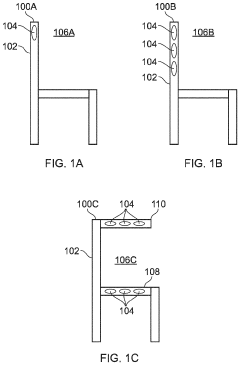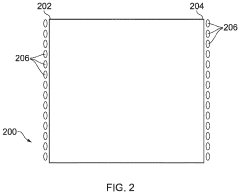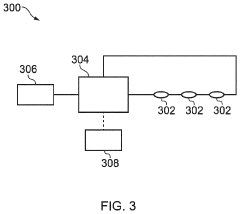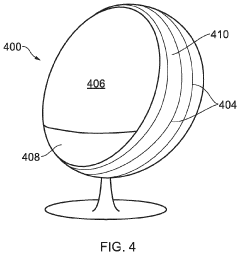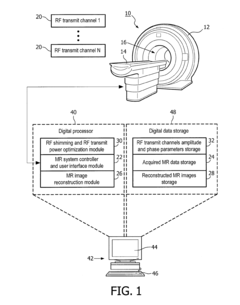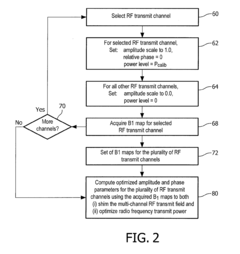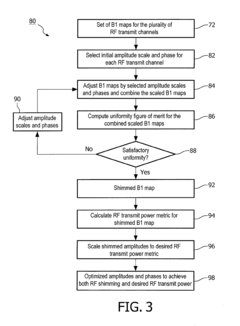How to Optimize Schumann Resonance-Based Research Methodologies?
JUN 24, 20259 MIN READ
Generate Your Research Report Instantly with AI Agent
Patsnap Eureka helps you evaluate technical feasibility & market potential.
Schumann Resonance Research Background and Objectives
Schumann resonances, discovered by Winfried Otto Schumann in 1952, are electromagnetic oscillations occurring in the Earth-ionosphere cavity. These resonances, with fundamental frequency around 7.83 Hz, have become a subject of increasing scientific interest due to their potential implications for global climate, human health, and geophysical phenomena.
The evolution of Schumann resonance research has been marked by significant technological advancements. Early studies relied on rudimentary equipment, limiting the accuracy and scope of observations. However, the advent of sophisticated sensors, high-precision magnetometers, and advanced signal processing techniques has revolutionized the field, enabling more precise measurements and broader applications.
Current research objectives in Schumann resonance studies are multifaceted. Scientists aim to enhance our understanding of the Earth's electromagnetic environment, investigate the resonances' role in global lightning activity, and explore their potential as indicators of ionospheric perturbations. Additionally, there is growing interest in utilizing Schumann resonances as a tool for monitoring global temperature changes and studying the Earth's water cycle.
A key focus area is the development of more sensitive detection methods to capture subtle variations in Schumann resonance parameters. This includes improving signal-to-noise ratios, refining data analysis techniques, and expanding the global network of monitoring stations. Researchers are also exploring the integration of Schumann resonance data with other geophysical measurements to create more comprehensive models of Earth's electromagnetic behavior.
The potential applications of optimized Schumann resonance research methodologies are vast. In climate science, they could provide a novel approach to tracking global temperature trends. In space weather forecasting, enhanced monitoring of Schumann resonances could offer early warnings of solar-induced disturbances. The medical field is investigating potential correlations between Schumann resonances and human health, particularly in areas such as circadian rhythms and neurological activity.
As technology continues to advance, the future of Schumann resonance research holds promising prospects. The integration of artificial intelligence and machine learning algorithms is expected to revolutionize data analysis, potentially uncovering previously undetected patterns and correlations. Furthermore, the miniaturization of sensing equipment may lead to more widespread deployment of monitoring stations, including in remote or challenging environments.
In conclusion, optimizing Schumann resonance-based research methodologies represents a critical step in advancing our understanding of Earth's electromagnetic environment and its far-reaching implications. The field stands at the intersection of multiple scientific disciplines, offering unique insights into global phenomena and opening new avenues for technological innovation.
The evolution of Schumann resonance research has been marked by significant technological advancements. Early studies relied on rudimentary equipment, limiting the accuracy and scope of observations. However, the advent of sophisticated sensors, high-precision magnetometers, and advanced signal processing techniques has revolutionized the field, enabling more precise measurements and broader applications.
Current research objectives in Schumann resonance studies are multifaceted. Scientists aim to enhance our understanding of the Earth's electromagnetic environment, investigate the resonances' role in global lightning activity, and explore their potential as indicators of ionospheric perturbations. Additionally, there is growing interest in utilizing Schumann resonances as a tool for monitoring global temperature changes and studying the Earth's water cycle.
A key focus area is the development of more sensitive detection methods to capture subtle variations in Schumann resonance parameters. This includes improving signal-to-noise ratios, refining data analysis techniques, and expanding the global network of monitoring stations. Researchers are also exploring the integration of Schumann resonance data with other geophysical measurements to create more comprehensive models of Earth's electromagnetic behavior.
The potential applications of optimized Schumann resonance research methodologies are vast. In climate science, they could provide a novel approach to tracking global temperature trends. In space weather forecasting, enhanced monitoring of Schumann resonances could offer early warnings of solar-induced disturbances. The medical field is investigating potential correlations between Schumann resonances and human health, particularly in areas such as circadian rhythms and neurological activity.
As technology continues to advance, the future of Schumann resonance research holds promising prospects. The integration of artificial intelligence and machine learning algorithms is expected to revolutionize data analysis, potentially uncovering previously undetected patterns and correlations. Furthermore, the miniaturization of sensing equipment may lead to more widespread deployment of monitoring stations, including in remote or challenging environments.
In conclusion, optimizing Schumann resonance-based research methodologies represents a critical step in advancing our understanding of Earth's electromagnetic environment and its far-reaching implications. The field stands at the intersection of multiple scientific disciplines, offering unique insights into global phenomena and opening new avenues for technological innovation.
Market Applications of Schumann Resonance Studies
Schumann resonance studies have found diverse market applications across various industries, leveraging the unique properties of these electromagnetic waves. In the field of geophysics and earth sciences, Schumann resonance monitoring systems are utilized for earthquake prediction and ionospheric research. These systems provide valuable data on global lightning activity and ionospheric conditions, enabling scientists to develop more accurate forecasting models for seismic events and space weather phenomena.
The telecommunications industry has shown increasing interest in Schumann resonance-based technologies for improving long-range communication systems. By exploiting the natural waveguide formed between the Earth's surface and the ionosphere, researchers are developing novel methods to enhance signal propagation and reduce interference in global communication networks. This application has potential implications for improving satellite communications, maritime navigation systems, and remote area connectivity.
In the realm of healthcare and wellness, Schumann resonance generators have gained popularity as therapeutic devices. Proponents claim that exposure to these low-frequency electromagnetic fields can help alleviate stress, improve sleep quality, and enhance overall well-being. While scientific evidence supporting these claims remains limited, the market for Schumann resonance-based wellness products continues to grow, particularly in the alternative medicine and holistic health sectors.
Environmental monitoring represents another significant market application for Schumann resonance studies. Researchers are developing advanced sensors and detection systems that utilize Schumann resonance measurements to track global climate patterns, monitor atmospheric electrical activity, and assess the impact of human activities on the Earth's electromagnetic environment. These tools provide valuable data for climate change research, environmental impact assessments, and long-term ecological studies.
The aerospace industry has also shown interest in Schumann resonance applications, particularly in the development of advanced navigation and positioning systems. By leveraging the global nature of Schumann resonances, researchers are exploring new methods for precise geolocation and orientation determination, which could complement or enhance existing GPS technologies. This application has potential benefits for both civilian and military aerospace operations, offering improved accuracy and reliability in navigation systems.
In the field of energy research, Schumann resonance studies are contributing to the development of novel power harvesting technologies. Scientists are investigating methods to tap into the Earth's natural electromagnetic field as a potential source of clean, renewable energy. While still in the early stages of research, this application could have significant implications for sustainable energy production in the future.
The telecommunications industry has shown increasing interest in Schumann resonance-based technologies for improving long-range communication systems. By exploiting the natural waveguide formed between the Earth's surface and the ionosphere, researchers are developing novel methods to enhance signal propagation and reduce interference in global communication networks. This application has potential implications for improving satellite communications, maritime navigation systems, and remote area connectivity.
In the realm of healthcare and wellness, Schumann resonance generators have gained popularity as therapeutic devices. Proponents claim that exposure to these low-frequency electromagnetic fields can help alleviate stress, improve sleep quality, and enhance overall well-being. While scientific evidence supporting these claims remains limited, the market for Schumann resonance-based wellness products continues to grow, particularly in the alternative medicine and holistic health sectors.
Environmental monitoring represents another significant market application for Schumann resonance studies. Researchers are developing advanced sensors and detection systems that utilize Schumann resonance measurements to track global climate patterns, monitor atmospheric electrical activity, and assess the impact of human activities on the Earth's electromagnetic environment. These tools provide valuable data for climate change research, environmental impact assessments, and long-term ecological studies.
The aerospace industry has also shown interest in Schumann resonance applications, particularly in the development of advanced navigation and positioning systems. By leveraging the global nature of Schumann resonances, researchers are exploring new methods for precise geolocation and orientation determination, which could complement or enhance existing GPS technologies. This application has potential benefits for both civilian and military aerospace operations, offering improved accuracy and reliability in navigation systems.
In the field of energy research, Schumann resonance studies are contributing to the development of novel power harvesting technologies. Scientists are investigating methods to tap into the Earth's natural electromagnetic field as a potential source of clean, renewable energy. While still in the early stages of research, this application could have significant implications for sustainable energy production in the future.
Current Challenges in Schumann Resonance Detection
Schumann resonance detection faces several significant challenges that hinder the optimization of research methodologies in this field. One of the primary obstacles is the extremely low frequency and amplitude of these signals, typically ranging from 7.83 Hz to 45 Hz with amplitudes in the picoTesla range. This low signal-to-noise ratio makes it difficult to isolate Schumann resonances from background electromagnetic noise, particularly in urban environments with high levels of anthropogenic electromagnetic interference.
The global nature of Schumann resonances presents another challenge, as these signals propagate worldwide within the Earth-ionosphere cavity. Researchers must account for variations in signal strength and characteristics due to geographical location, time of day, and seasonal changes. This variability complicates the process of obtaining consistent and comparable measurements across different research sites and time periods.
Furthermore, the complex interplay between Schumann resonances and various geophysical phenomena, such as solar activity, lightning strikes, and ionospheric disturbances, adds layers of complexity to the detection and interpretation of these signals. Disentangling the effects of these various factors requires sophisticated data analysis techniques and a comprehensive understanding of multiple scientific disciplines.
The limitations of current sensing technologies also pose significant challenges. While induction coil magnetometers are commonly used for Schumann resonance detection, they are susceptible to temperature fluctuations and mechanical vibrations, which can introduce artifacts into the data. Additionally, the need for highly sensitive equipment often results in bulky and expensive setups, limiting the widespread deployment of Schumann resonance monitoring stations.
Data processing and analysis present their own set of challenges. The vast amounts of data generated by continuous monitoring require efficient storage, processing, and analysis methods. Developing robust algorithms for signal extraction, noise reduction, and feature identification is crucial for accurate interpretation of Schumann resonance data.
Lastly, the interdisciplinary nature of Schumann resonance research creates challenges in standardizing methodologies and interpreting results across different scientific communities. Bridging the gap between atmospheric physics, geophysics, and electrical engineering is essential for advancing our understanding of these phenomena and optimizing research methodologies.
The global nature of Schumann resonances presents another challenge, as these signals propagate worldwide within the Earth-ionosphere cavity. Researchers must account for variations in signal strength and characteristics due to geographical location, time of day, and seasonal changes. This variability complicates the process of obtaining consistent and comparable measurements across different research sites and time periods.
Furthermore, the complex interplay between Schumann resonances and various geophysical phenomena, such as solar activity, lightning strikes, and ionospheric disturbances, adds layers of complexity to the detection and interpretation of these signals. Disentangling the effects of these various factors requires sophisticated data analysis techniques and a comprehensive understanding of multiple scientific disciplines.
The limitations of current sensing technologies also pose significant challenges. While induction coil magnetometers are commonly used for Schumann resonance detection, they are susceptible to temperature fluctuations and mechanical vibrations, which can introduce artifacts into the data. Additionally, the need for highly sensitive equipment often results in bulky and expensive setups, limiting the widespread deployment of Schumann resonance monitoring stations.
Data processing and analysis present their own set of challenges. The vast amounts of data generated by continuous monitoring require efficient storage, processing, and analysis methods. Developing robust algorithms for signal extraction, noise reduction, and feature identification is crucial for accurate interpretation of Schumann resonance data.
Lastly, the interdisciplinary nature of Schumann resonance research creates challenges in standardizing methodologies and interpreting results across different scientific communities. Bridging the gap between atmospheric physics, geophysics, and electrical engineering is essential for advancing our understanding of these phenomena and optimizing research methodologies.
Existing Methodologies for Schumann Resonance Analysis
01 Measurement and analysis of Schumann resonance signals
Research methodologies focus on measuring and analyzing Schumann resonance signals using specialized equipment. This involves detecting extremely low frequency (ELF) electromagnetic waves in the Earth-ionosphere cavity. Advanced signal processing techniques are employed to extract meaningful data from these measurements, allowing researchers to study variations in the Earth's electromagnetic field.- Measurement and analysis of Schumann resonance signals: Research methodologies focus on measuring and analyzing Schumann resonance signals using specialized equipment. This involves detecting extremely low frequency (ELF) electromagnetic waves in the Earth-ionosphere cavity. Advanced signal processing techniques are employed to extract meaningful data from these measurements, which can be used to study various atmospheric and geophysical phenomena.
- Development of Schumann resonance detection devices: Researchers are developing innovative devices specifically designed to detect and monitor Schumann resonances. These devices often incorporate sensitive antennas, amplifiers, and filters to capture the weak ELF signals. Some designs focus on portability and energy efficiency, allowing for long-term field measurements in remote locations.
- Application of machine learning and AI in Schumann resonance research: Advanced computational techniques, including machine learning and artificial intelligence, are being applied to Schumann resonance research. These methods help in pattern recognition, data analysis, and prediction of Schumann resonance-related phenomena. AI algorithms can process large datasets to identify correlations and trends that may not be apparent through traditional analysis methods.
- Integration of Schumann resonance data with other environmental parameters: Research methodologies are exploring the integration of Schumann resonance data with other environmental and geophysical parameters. This holistic approach combines Schumann resonance measurements with data on weather patterns, seismic activity, and ionospheric conditions to gain a more comprehensive understanding of Earth's electromagnetic environment and its interactions with various natural phenomena.
- Schumann resonance simulation and modeling techniques: Researchers are developing sophisticated simulation and modeling techniques to study Schumann resonances. These computational models aim to replicate the behavior of electromagnetic waves in the Earth-ionosphere cavity under various conditions. Such simulations help in understanding the factors influencing Schumann resonances and in predicting their characteristics in different scenarios.
02 Development of Schumann resonance detection devices
Researchers are developing innovative devices specifically designed to detect and monitor Schumann resonances. These devices often incorporate sensitive antennas, amplifiers, and filters to capture the weak ELF signals. Some designs focus on portability and ease of use, enabling field measurements in various locations.Expand Specific Solutions03 Application of machine learning and AI in Schumann resonance research
Advanced computational techniques, including machine learning and artificial intelligence, are being applied to Schumann resonance research. These methods help in pattern recognition, data analysis, and prediction of Schumann resonance behavior. AI algorithms can process large datasets to identify correlations and trends that may not be apparent through traditional analysis methods.Expand Specific Solutions04 Integration of Schumann resonance monitoring in environmental and health studies
Schumann resonance research is being integrated into broader environmental and health studies. Methodologies are being developed to investigate potential correlations between Schumann resonance variations and various environmental factors or human health parameters. This interdisciplinary approach combines electromagnetic measurements with data from other fields such as meteorology, geophysics, and biology.Expand Specific Solutions05 Simulation and modeling of Schumann resonances
Researchers are developing sophisticated simulation and modeling techniques to study Schumann resonances. These computational methods allow for the prediction of resonance behavior under various conditions and help in understanding the complex interactions within the Earth-ionosphere cavity. Such models can be used to complement experimental data and guide future research directions.Expand Specific Solutions
Key Players in Schumann Resonance Research
The optimization of Schumann Resonance-based research methodologies is in a nascent stage of development, with a growing market driven by increasing interest in Earth-ionosphere cavity resonances. The technology's maturity is still evolving, as evidenced by the diverse range of companies involved. Key players like Siemens Healthineers AG, Koninklijke Philips NV, and Bruker Switzerland are contributing to advancements in measurement techniques and data analysis. Academic institutions such as Northwestern Polytechnical University and New York University are also playing crucial roles in pushing the boundaries of this field. The competitive landscape is characterized by a mix of established tech giants and specialized research institutions, indicating a collaborative approach to solving complex challenges in Schumann Resonance research.
Siemens Healthineers AG
Technical Solution: Siemens Healthineers has developed advanced electromagnetic field sensors and signal processing algorithms to detect and analyze Schumann resonances. Their approach involves using highly sensitive magnetometers combined with sophisticated noise reduction techniques to isolate the weak Schumann signals from background electromagnetic noise. The company has also implemented machine learning algorithms to identify patterns and correlations in the Schumann resonance data, potentially linking these signals to various geophysical and biological phenomena.
Strengths: Advanced sensor technology and signal processing capabilities. Weaknesses: Limited focus on Schumann resonance research compared to their primary healthcare technologies.
Koninklijke Philips NV
Technical Solution: Philips has integrated Schumann resonance monitoring into their environmental sensing and healthcare solutions. They have developed compact, low-power sensors that can detect Schumann resonances in various settings, including indoor environments. Philips' approach focuses on correlating Schumann resonance data with human health metrics, exploring potential applications in sleep quality monitoring and stress reduction. Their research methodology includes long-term data collection and analysis to identify potential health impacts of natural electromagnetic field variations.
Strengths: Integration with existing health monitoring systems. Weaknesses: Limited public research on specific Schumann resonance optimization techniques.
Innovative Approaches in Schumann Resonance Detection
A magnetic field exposure system and uses thereof
PatentPendingUS20230372726A1
Innovation
- A magnetic field exposure system generating an amplitude-modulated low frequency magnetic field with a carrier frequency of 360 to 450 Hz and a modulation frequency of 0.5 to 100 Hz, providing a field strength of 0.5 to 250 μT, specifically designed to enhance cell survival, proliferation, reduce stress, and promote tissue regeneration.
Concurrent optimization of RF power and RF field uniformity in MRI
PatentInactiveUS20120161766A1
Innovation
- Acquiring B1 maps for multiple RF transmit channels and computing optimized amplitude and phase parameters using a digital processor to shim the RF transmit field for uniformity and optimize RF transmit power, allowing the channels to operate in a multi-channel transmit mode with improved accuracy.
Environmental Factors Affecting Schumann Resonance
Schumann resonances, the global electromagnetic resonances generated and excited by lightning discharges in the cavity formed by the Earth's surface and the ionosphere, are significantly influenced by various environmental factors. These factors play a crucial role in shaping the characteristics and behavior of Schumann resonances, thereby affecting research methodologies and data interpretation.
One of the primary environmental factors impacting Schumann resonances is the global lightning activity. The frequency and intensity of lightning strikes across different regions of the Earth directly correlate with the strength and variability of Schumann resonances. Seasonal changes in lightning patterns, particularly in tropical regions, can lead to notable fluctuations in resonance measurements.
Ionospheric conditions also play a vital role in modulating Schumann resonances. The height and electron density of the ionosphere, which vary with solar activity and diurnal cycles, affect the propagation of electromagnetic waves within the Earth-ionosphere cavity. Solar flares and geomagnetic storms can cause significant perturbations in the ionosphere, leading to temporary alterations in Schumann resonance parameters.
Atmospheric conductivity is another critical factor influencing Schumann resonances. Changes in air ionization due to cosmic rays, radioactive decay, and anthropogenic sources can modify the electrical properties of the atmosphere, affecting the transmission of electromagnetic waves. Variations in atmospheric conductivity can lead to shifts in resonance frequencies and amplitudes.
Terrestrial factors, such as the Earth's magnetic field and geological activities, also contribute to the complexity of Schumann resonance measurements. Magnetic field variations can influence the propagation of electromagnetic waves, while seismic activities and changes in ground conductivity may affect the local electromagnetic environment.
Human activities and technological advancements have introduced additional environmental factors affecting Schumann resonances. Electromagnetic pollution from power lines, communication systems, and industrial activities can interfere with measurements and potentially alter the natural resonance patterns. Urbanization and changes in land use may also impact local electromagnetic conditions.
Climate change and its associated phenomena, such as alterations in global temperature patterns and extreme weather events, can indirectly influence Schumann resonances by modifying lightning activity and atmospheric composition. Long-term changes in these environmental factors may lead to subtle shifts in Schumann resonance characteristics over time.
Understanding and accounting for these environmental factors is crucial for optimizing Schumann resonance-based research methodologies. Researchers must develop robust techniques to isolate and quantify the impact of various environmental influences on resonance measurements, ensuring accurate data interpretation and reliable scientific conclusions.
One of the primary environmental factors impacting Schumann resonances is the global lightning activity. The frequency and intensity of lightning strikes across different regions of the Earth directly correlate with the strength and variability of Schumann resonances. Seasonal changes in lightning patterns, particularly in tropical regions, can lead to notable fluctuations in resonance measurements.
Ionospheric conditions also play a vital role in modulating Schumann resonances. The height and electron density of the ionosphere, which vary with solar activity and diurnal cycles, affect the propagation of electromagnetic waves within the Earth-ionosphere cavity. Solar flares and geomagnetic storms can cause significant perturbations in the ionosphere, leading to temporary alterations in Schumann resonance parameters.
Atmospheric conductivity is another critical factor influencing Schumann resonances. Changes in air ionization due to cosmic rays, radioactive decay, and anthropogenic sources can modify the electrical properties of the atmosphere, affecting the transmission of electromagnetic waves. Variations in atmospheric conductivity can lead to shifts in resonance frequencies and amplitudes.
Terrestrial factors, such as the Earth's magnetic field and geological activities, also contribute to the complexity of Schumann resonance measurements. Magnetic field variations can influence the propagation of electromagnetic waves, while seismic activities and changes in ground conductivity may affect the local electromagnetic environment.
Human activities and technological advancements have introduced additional environmental factors affecting Schumann resonances. Electromagnetic pollution from power lines, communication systems, and industrial activities can interfere with measurements and potentially alter the natural resonance patterns. Urbanization and changes in land use may also impact local electromagnetic conditions.
Climate change and its associated phenomena, such as alterations in global temperature patterns and extreme weather events, can indirectly influence Schumann resonances by modifying lightning activity and atmospheric composition. Long-term changes in these environmental factors may lead to subtle shifts in Schumann resonance characteristics over time.
Understanding and accounting for these environmental factors is crucial for optimizing Schumann resonance-based research methodologies. Researchers must develop robust techniques to isolate and quantify the impact of various environmental influences on resonance measurements, ensuring accurate data interpretation and reliable scientific conclusions.
Data Processing and Interpretation Techniques
Data processing and interpretation techniques play a crucial role in optimizing Schumann resonance-based research methodologies. The first step in this process involves data acquisition, where high-quality, low-noise electromagnetic sensors are deployed to capture the extremely low frequency (ELF) signals associated with Schumann resonances. These sensors must be carefully calibrated and positioned to minimize interference from anthropogenic sources and maximize signal-to-noise ratio.
Once the raw data is collected, it undergoes preprocessing to remove artifacts and unwanted noise. This typically involves applying various digital filters, such as notch filters to remove power line interference, and band-pass filters to isolate the frequency range of interest (typically 7-60 Hz for Schumann resonances). Advanced signal processing techniques, such as adaptive filtering and wavelet analysis, can be employed to further enhance the signal quality and extract relevant features.
Spectral analysis forms the cornerstone of Schumann resonance data interpretation. Fast Fourier Transform (FFT) algorithms are commonly used to convert time-domain signals into frequency-domain representations, allowing researchers to identify and characterize the distinct resonance modes. However, the non-stationary nature of Schumann resonances necessitates the use of more sophisticated time-frequency analysis methods, such as Short-Time Fourier Transform (STFT) or continuous wavelet transform (CWT), to capture temporal variations in resonance parameters.
Machine learning and artificial intelligence techniques are increasingly being applied to Schumann resonance data analysis. These methods can help identify subtle patterns and correlations that may not be apparent through traditional analysis approaches. For instance, neural networks can be trained to automatically detect and classify Schumann resonance events, while clustering algorithms can be used to identify different types of resonance patterns associated with various geophysical phenomena.
To ensure the reliability and reproducibility of research findings, it is essential to implement robust statistical analysis techniques. This includes methods for estimating uncertainties in measured parameters, assessing the significance of observed variations, and conducting hypothesis tests to evaluate the validity of proposed relationships between Schumann resonances and other geophysical or atmospheric phenomena.
Visualization techniques play a vital role in interpreting and communicating Schumann resonance data. Dynamic spectrograms, 3D waterfall plots, and interactive data dashboards can provide intuitive representations of complex resonance patterns and their temporal evolution. These visual tools are particularly valuable for identifying long-term trends, seasonal variations, and anomalous events in Schumann resonance behavior.
Once the raw data is collected, it undergoes preprocessing to remove artifacts and unwanted noise. This typically involves applying various digital filters, such as notch filters to remove power line interference, and band-pass filters to isolate the frequency range of interest (typically 7-60 Hz for Schumann resonances). Advanced signal processing techniques, such as adaptive filtering and wavelet analysis, can be employed to further enhance the signal quality and extract relevant features.
Spectral analysis forms the cornerstone of Schumann resonance data interpretation. Fast Fourier Transform (FFT) algorithms are commonly used to convert time-domain signals into frequency-domain representations, allowing researchers to identify and characterize the distinct resonance modes. However, the non-stationary nature of Schumann resonances necessitates the use of more sophisticated time-frequency analysis methods, such as Short-Time Fourier Transform (STFT) or continuous wavelet transform (CWT), to capture temporal variations in resonance parameters.
Machine learning and artificial intelligence techniques are increasingly being applied to Schumann resonance data analysis. These methods can help identify subtle patterns and correlations that may not be apparent through traditional analysis approaches. For instance, neural networks can be trained to automatically detect and classify Schumann resonance events, while clustering algorithms can be used to identify different types of resonance patterns associated with various geophysical phenomena.
To ensure the reliability and reproducibility of research findings, it is essential to implement robust statistical analysis techniques. This includes methods for estimating uncertainties in measured parameters, assessing the significance of observed variations, and conducting hypothesis tests to evaluate the validity of proposed relationships between Schumann resonances and other geophysical or atmospheric phenomena.
Visualization techniques play a vital role in interpreting and communicating Schumann resonance data. Dynamic spectrograms, 3D waterfall plots, and interactive data dashboards can provide intuitive representations of complex resonance patterns and their temporal evolution. These visual tools are particularly valuable for identifying long-term trends, seasonal variations, and anomalous events in Schumann resonance behavior.
Unlock deeper insights with Patsnap Eureka Quick Research — get a full tech report to explore trends and direct your research. Try now!
Generate Your Research Report Instantly with AI Agent
Supercharge your innovation with Patsnap Eureka AI Agent Platform!
